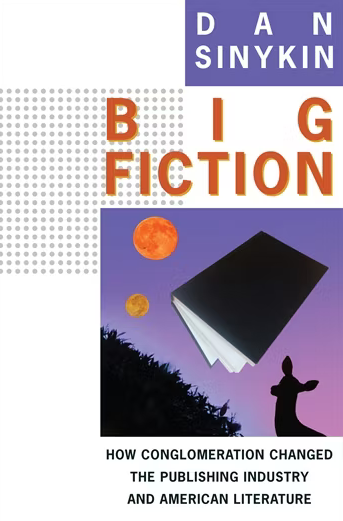Big Fiction: How Conglomeration Changed the Publishing Industry and American Literature
- By Dan Sinykin
- Columbia University Press
- 328 pp.
- Reviewed by John P. Loonam
- November 13, 2023
What does consolidation at the top mean for readers?

Publishing companies have always helped decide what literature is, who should produce it, and (through format and pricing decisions) who should read it. So, it’s reasonable to expect that changes within those corporations affect not only who sells books to whom, but the content and form of literature itself.
In Big Fiction, Dan Sinykin tells the story of how conglomeration has impacted the substance and style of the fiction published in America. He outlines the history of the publishing industry and gives close readings of several novels — by writers as diverse as Toni Morrison, E.L. Doctorow, and Stephen King — that, in his view, offer commentary on those changes.
For decades, commercial publishers proliferated in the United States. Some — like Harper, Houghton Mifflin, and Scribner — date back to the 19th century, while others — including Knopf, Random House, and Viking — arrived in the 1910s and 1920s, often started by immigrants. In 1939, Pocket Books invented and began selling the mass-market paperback and was soon followed by Dell, Bantam, and Fawcett. The trend toward proliferation changed in 1959 when Random House went public, using money raised to buy competitor Knopf. That began an era of mergers and acquisitions that’s not over yet, though today, more than 80 percent of the U.S. book market is controlled by just five firms.
Sinykin centers his narrative around the 1990 firing of esteemed editor André Schiffrin by a new Random House president who’d formerly been an auto executive. To many, Schiffrin’s termination heralded the death of literature, but Sinykin is less judgmental and more interested in describing changes than decrying them.
“I don’t believe the novels written in the last forty years are worse than those written in the forty years previous,” he writes. “This is, instead, a tale of transformation.” He closely examines that transformation here, finding (unsurprisingly) that conglomerate publishers focus on the bottom line, making them prefer steady and predictable profits over brave new voices.
Sinykin explores two ways profits have been regularized. First was by the expansion of genre literature. When data identified that fantasy, romance, science fiction, and detective fiction are the bestselling genres in the U.S., publishers responded by expanding their production of these genres. In search of profits that could be as steady and predictable as in other industries, they began to offer series by the same authors that followed the same characters and settings, like Piers Anthony’s Xanth or Julia Quinn’s Bridgerton. Developing and then rewarding audience loyalty makes for good business.
The second trend has been the rise of the brand-name author — think Stephen King, Danielle Steel, and John Grisham. Sinykin says little about the quality of their work, focusing instead on how important being prolific has been to their success. For example, Steel had a long period in which she wrote six novels a year. If the job of both novelist and publisher is to give the people what they want, sales figures make clear that these big names are it.
Of course, American literature has continued to produce individual, not-quite-so-prolix voices, but they’re less likely to emerge via commercial publishing. Focusing on independent-minded nonprofit publishers like Graywolf, Coffee House, and Milkweed, Sinykin recounts how, far from New York, the infrastructure for a viable alternative to the conglomerates was built from scratch. Rather than present these presses as beacons of free expression, though, he examines how the priorities of the foundation world (especially multiculturism) came to be the focus of the presses that rely on its largesse.
In a close reading of contemporary literature, Sinykin examines how the prose in nonprofit-published novels differs from conglomerate-published prose, arguing that “nonprofit novels privilege embodiment, craft, and localism,” while conglomerate offerings feature the “language of law and power, bureaucracy, and disposition.” Yet his chief example of these differences is Toni Morrison’s Beloved, a novel published by a conglomerate (and written by a woman who’d had a long career with that conglomerate) but that contains language rich with the concerns of the nonprofit world: “What it means to live in a body.” That Beloved is also about law and power only muddies his case further.
Sinykin’s thematic readings can be similarly unconvincing. E.L. Doctorow’s Ragtime and Stephen King’s Misery may be protests against conglomeration, but the individual’s fight against larger forces of conformity is the subject of much of American literature (just ask Huck Finn, Lily Bart, or Tom Joad).
Big Fiction is full of fascinating anecdotes and factoids. Who knew Danielle Steel wrote in four languages or that Mickey Spillane was a serious Jehovah’s Witness? But its academic format involves an extensive introduction and conclusion to each chapter. These help cohere Sinykin’s argument but become repetitive. Poor André Schiffrin is fired half-a-dozen times.
Despite these quibbles, Big Fiction is an important book. In his chapter on W.W. Norton, the sole remaining large independent U.S. publisher, Sinykin explains that it has avoided conglomeration because of the steady profits of its anthologies. The Norton Anthology series has literally defined what literature is for millions of American college students over several generations. But that’s what publishers, large and small, do. Even as new technologies like the Kindle and Audible are profoundly changing the industry, Sinykin’s work will help committed readers think about those changes intelligently.
John P. Loonam has a Ph.D. in American literature from the City University of New York and taught English in New York City public schools for over 35 years. He has published fiction in various journals and anthologies, and his short plays have been featured by the Mottola Theater Project several times. He is married and the father of two sons; the four have lived in Brooklyn long enough to be considered natives by anyone but his neighbors.

_80_121.png)